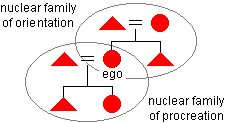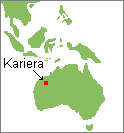Descent
Groups
Different descent
principles and marriage rules result in the formation of different types of
families and larger kin based groups.
Regardless of the descent and marriage pattern used by a society, however,
most people at some time in their lives are members of more than one family
group. For example, in North
America and other monogamous societies with
bilateral
descent patterns, people usually see themselves as being members of two related
nuclear
 families--the one in which they are a child
(family of orientation
families--the one in which they are a child
(family of orientation
 ) and the one in which they are a parent (family of
procreation
) and the one in which they are a parent (family of
procreation
 ).
).
In reality, the
21st
century American family is often missing an adult male as a result of death, divorce,
abandonment, or no marriage having occurred. Such families are often referred to as
being matricentric
 or matrifocused
or matrifocused
 . They may also include the mother's
daughter's children, as in the case shown in the diagram below. The
matricentric family pattern exists in all segments of the American society
today but is most common in poor urban African American communities.
. They may also include the mother's
daughter's children, as in the case shown in the diagram below. The
matricentric family pattern exists in all segments of the American society
today but is most common in poor urban African American communities.

In some cases, it is the wife-mother
who is absent from the family. As a result, the husband-father usually
takes on both parent roles. Another
increasingly common form of family in contemporary America is the dual-family.
This occurs when children move between the separate
households of their divorced or separated parents. Since half of all
marriages in the U.S. now end in divorce, it is likely that the dual-family
will become a more accepted family alternative.
Unilineal
Descent Groups
When a
unilineal descent principle is used, people are
most often members of multi-generational groups of close relatives called
unilineages
 .
These may be matrilineages
.
These may be matrilineages
 , as in the case of the green people
in the diagram below, or they may
be patrilineages
, as in the case of the green people
in the diagram below, or they may
be patrilineages
 , depending on whether the links are traced through women or men.
, depending on whether the links are traced through women or men.
 |
|
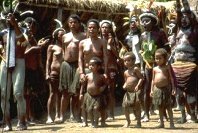 |
|
Three generations
of a small matrilineage |
Members of a
unilineage in New Guinea |
Societies that have
unilineages also often define larger, more inclusive kin groups called
clans
 .
These are groups of people who claim unilineal descent from a common ancestor but who
cannot specify all of the actual links. The ancestor is genealogically
.
These are groups of people who claim unilineal descent from a common ancestor but who
cannot specify all of the actual links. The ancestor is genealogically
 so remote that he or she is thought of
often as a mythical being.
so remote that he or she is thought of
often as a mythical being.

|
|
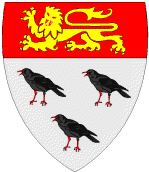
|
Typical
English crest
with heraldic animals |
Such distant, non-human
ancestors become identifying symbols of the clan. Anthropologists often refer to
these fictional clan originators as totems
 or totemic emblems
or totemic emblems
 . Often, there
are cultural rules requiring that clan members show respect for the totemic animal or
plant and observe a prohibition against killing or eating it. Medieval European
heraldry also used animal representations to identify family lines. However, such
creatures were not considered to be family ancestors but rather as symbolic
representations of virtues such as strength and loyalty.
. Often, there
are cultural rules requiring that clan members show respect for the totemic animal or
plant and observe a prohibition against killing or eating it. Medieval European
heraldry also used animal representations to identify family lines. However, such
creatures were not considered to be family ancestors but rather as symbolic
representations of virtues such as strength and loyalty.
Australian
Aboriginal bark
painting showing totemic
ancestors in the "dreamtime"
(the mythical
time when the
world was created) |
|
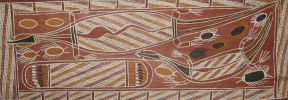 |
|
Some societies group their
clans into even larger-scale unilineal descent groups called
phratries
 . As
with clans, the actual genealogical links are not clear and the phratry ancestors are
usually mythical.
. As
with clans, the actual genealogical links are not clear and the phratry ancestors are
usually mythical.

Entire societies may be
divided into two large unilineal descent groups that have
reciprocal responsibilities
with each other. These groups are known as moieties
 (from the French word for
half). The distinction between phratries and moieties is not simply a matter of the
number of groupings. Moieties are intended to produce a balanced opposition within
a society. The constantly reinforced social and economic exchanges between
moieties
encourages economic equality and political stability.
(from the French word for
half). The distinction between phratries and moieties is not simply a matter of the
number of groupings. Moieties are intended to produce a balanced opposition within
a society. The constantly reinforced social and economic exchanges between
moieties
encourages economic equality and political stability.

The often complex patterns of reciprocity inherent in
moiety systems can be seen operating in the marriage patterns of the Kariera
Aborigines of Western Australia. They follow patrilineal descent but with a peculiar
twist that is known by anthropologists as a four class system. They have two
moieties and four "marriage classes." An individual's moitey and marriage
class identity determines who he or she may marry.
Each Kariera moiety has two
generational marriage class "names." Everyone in a moiety who is in the
same generation has the same marriage class identity. For simplicity, the moieties
are designated below as "A" and "B", while the marriage class "names" are "a", "b", "c", and "d"
respectively.
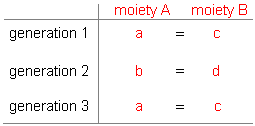
An "a" man
can only marry a "c"
woman from moiety "B". Their children will be
"b's" in moiety "A".
Conversely, a "c" man
can only marry a woman from
moiety "A" and their children will be "d's" in moiety "B".
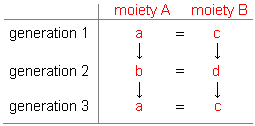
Ideally, Kariera men from
different moieties marry each other's sisters. This results in strong reciprocal
bonds between the men and their moieties. There is a generational alternation in
class "names" among the Kariera. People have the same class identity as
their grandparents and grandchildren but not their parents and children. It is
sobering to note that as confusing as the Kariera 4-class system seems, it is not the most
complex example of Australian Aboriginal kinship.
Societies with moieties
usually consist of a few thousand people or less. In contrast, societies with
phratries are often larger. As in the case of clans and phratries, moiety members
usually cannot demonstrate all of the descent links back to their supposed common
ancestor.
Membership in unilineages,
clans, moieties, and phratries is inherited and usually continues throughout life.
As a result, these unilineal descent groups often function successfully as long-term joint
property owners and economic production teams.
Bilateral Descent Groups
Bilateral descent groups
tend to be more fragile and short term than unilineal ones. Beyond the
nuclear family, there usually only exists a
kindred
 .
This is a group of relatives who are linked together by a single individual who can trace
descent and/or marriage relationships to every other member of the kindred.
.
This is a group of relatives who are linked together by a single individual who can trace
descent and/or marriage relationships to every other member of the kindred.
In North America today, a
kindred group usually informally includes spouses and in-laws as well as biological
relatives. All of the people below may be part of ego's kindred.

This loosely defined type of kindred allows people to be part of the extended families of their
spouses as well as their own. An unfortunate
consequence is divided family
loyalties when an issue comes
up that places consanguinal relatives and affines on opposite sides. Conflicting interests
and obligations usually prevent such expanded kindreds from functioning as efficiently as
a unilineage in collective ownership and mutual aid.
North American kindreds are not
only fragile but also usually short term social groupings. When an individual dies
or is divorced, the kindred that was focused on him or her is altered significantly or may
even cease existing. The only kind of bilateral
kindred that regularly continues to exist after the death of its founder is a dead
ancestor focused one. For example, members of the well known, politically active
Kennedy family of Massachusetts, which has included a U.S. President and several Senators,
still considers themselves to be a large closely related kindred despite the fact that Joe
Kennedy, the family founder, died in 1969 and many of the Kennedy kindred do not have the
Kennedy name.
This page was last
updated on
Friday, March 16, 2007.
Copyright © 1997-2006 by
Dennis O'Neil. All rights reserved.
Illustration credits
![]() families--the one in which they are a child
(family of orientation
families--the one in which they are a child
(family of orientation
![]() ) and the one in which they are a parent (family of
procreation
) and the one in which they are a parent (family of
procreation
![]() ).
).